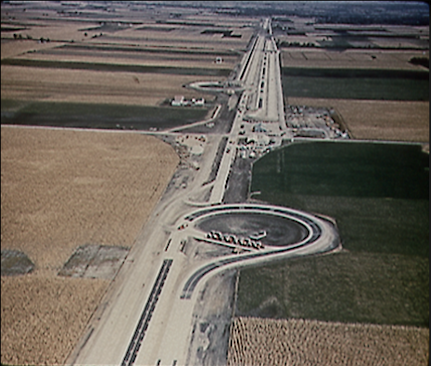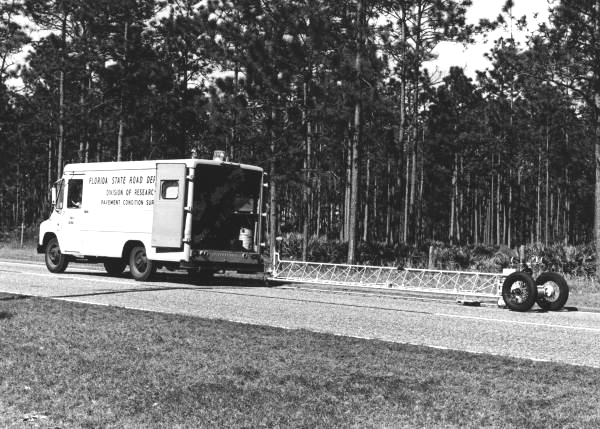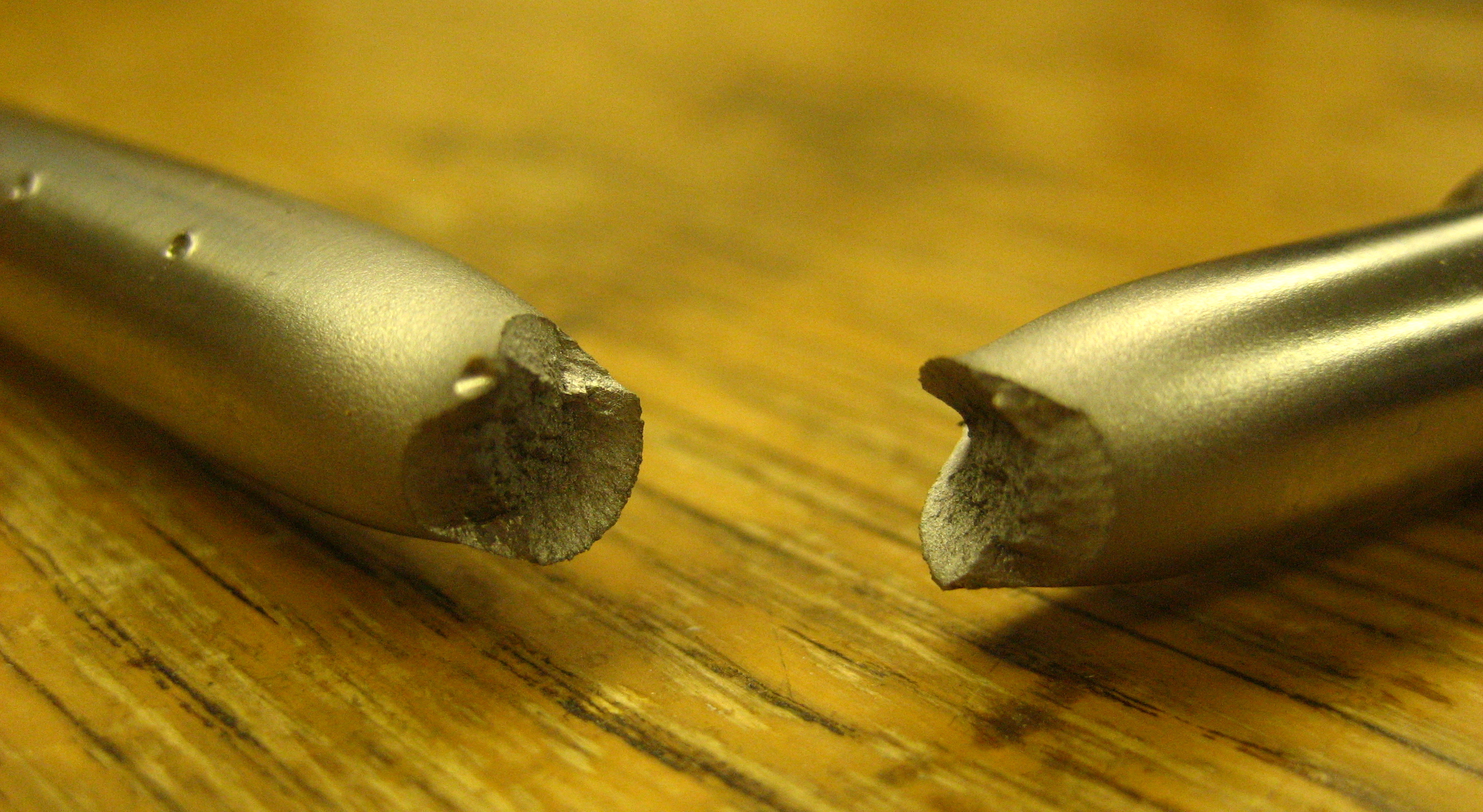|
AASHO Road Test
The AASHO Road Test was a series of experiments carried out by the American Association of State Highway and Transportation Officials (AASHTO), to determine how traffic contributed to the deterioration of highway pavements. Methodology The AASHO road test was to study the performance of pavement structures of known thickness under moving loads of known magnitude and frequency. The study was carried out from August 1956 to November 30, 1960 in Ottawa, Illinois and has been used as a primary source of experimental data when vehicle wear to highways is considered, for the purposes of road design, vehicle taxation, and cost. The road test consisted of six two-lane loops along the future alignment of Interstate 80. Each lane was subjected to repeated loading by a specific vehicle type and weight. The pavement structure within each loop was varied so that the interaction of vehicle loads and pavement structure could be investigated. Satellite studies were planned in other parts of ... [...More Info...] [...Related Items...] OR: [Wikipedia] [Google] [Baidu] |
AASHO Road Test - Areal View
The American Association of State Highway and Transportation Officials (AASHTO) is a standards setting body which publishes specifications, test protocols, and guidelines that are used in highway design and construction throughout the United States. Despite its name, the association represents not only highways but air, rail, water, and public transportation as well. Although AASHTO sets transportation standards and policy for the United States as a whole, AASHTO is not an agency of the federal government; rather it is an organization of the states themselves. Policies of AASHTO are not federal laws or policies, but rather are ways to coordinate state laws and policies in the field of transportation. Purpose The American Association of State Highway Officials (AASHO) was founded on December 12, 1914. Its name was changed to American Association of State Highway and Transportation Officials on November 13, 1973. The name change reflects a broadened scope to cover all modes of ... [...More Info...] [...Related Items...] OR: [Wikipedia] [Google] [Baidu] |
Ride Quality
Ride quality refers to a vehicle's effectiveness in insulating the occupants from undulations in the road surface such as bumps or corrugations. A vehicle with good ride quality provides comfort for the driver and the passengers. Importance Good ride quality provides comfort for the people inside the car, minimises damage to cargo and can reduce driver fatigue on long journeys in uncomfortable vehicles, and also because road disruption can impact the driver's ability to control the vehicle. Suspension design is often a compromise between ride quality and car handling because cars with firm suspension can result in greater control of body movements and quicker reactions. Similarly, a lower center of gravity is more ideal for handling, but low ground clearance limits suspension travel and requires stiffer springs. Ambulances have a special need for a high level of ride quality to avoid further injury to the already-ill passengers. Technology Early vehicles, like the Ford Model ... [...More Info...] [...Related Items...] OR: [Wikipedia] [Google] [Baidu] |
Profilograph
Road surface textures are deviations from a planar and smooth surface, affecting the vehicle/tyre interaction. Pavement texture is divided into: microtexture with wavelengths from 0 mm to , macrotexture with wavelengths from to and megatexture with wavelengths from to . Microtexture Microtexture (MiTx) is the collaborative term for a material's crystallographic parameters and other aspects of microstructure: such as morphology, including size and shape distributions; chemical composition; and crystal orientation and relationships While vehicle suspension deflection and dynamic tire loads are affected by longer wavelength ( roughness), road texture affects the interaction between the road surface and the tire footprint. Microtexture has wavelengths shorter than 0.5 mm. It relates to the surface of the binder, of the aggregate, and of contaminants such as rubber deposits from tires. The mix of the road material contributes to dry road surface friction. Typically, r ... [...More Info...] [...Related Items...] OR: [Wikipedia] [Google] [Baidu] |
Fracture
Fracture is the appearance of a crack or complete separation of an object or material into two or more pieces under the action of stress (mechanics), stress. The fracture of a solid usually occurs due to the development of certain displacement discontinuity surfaces within the solid. If a displacement develops perpendicular to the surface, it is called a normal tensile crack or simply a crack; if a displacement develops tangentially, it is called a shear crack, slip band, or dislocation. #Brittle, Brittle fractures occur without any apparent deformation before fracture. #Ductile, Ductile fractures occur after visible deformation. Fracture strength, or breaking strength, is the stress when a specimen fails or fractures. The detailed understanding of how a fracture occurs and develops in materials is the object of fracture mechanics. Strength Fracture strength, also known as breaking strength, is the stress at which a specimen structural integrity and failure, fails via fra ... [...More Info...] [...Related Items...] OR: [Wikipedia] [Google] [Baidu] |
Rut (roads)
A rut is a depression or groove worn into a road or path by the travel of wheels or skis. Ruts can be formed by wear, as from studded tires, studded snow tires common in cold climate areas, or they can form through the deformation of the asphalt concrete, pavement or subbase (pavement), subbase material. In modern roads the main cause is heavily loaded trucks. These heavy loaded trucks imprint their tire impressions on roads over time, causing ruts. Rut is a common pavement distress and is often used in pavement performance modeling. Ruts prevent rainwater from flowing to the side of the road into ditches or gutters. Rainwater trapped in ruts is a common contributing factor to hydroplaning (tires), hydroplaning crashes. Severe ruts can impede steering if a vehicle has difficulty steering out of the rut. If it proves impossible to steer out of a rut, though forward and backward progress can be made by the vehicle, it is referred to as being stuck in the rut. Ruts in gravel roads ... [...More Info...] [...Related Items...] OR: [Wikipedia] [Google] [Baidu] |
Surface Roughness
Surface roughness or simply roughness is the quality of a surface of not being smooth and it is hence linked to human ( haptic) perception of the surface texture. From a mathematical perspective it is related to the spatial variability structure of surfaces, and inherently it is a multiscale property. It has different interpretations and definitions depending on the disciplines considered. In surface metrology, surface roughness is a component of surface finish (surface texture). It is quantified by the deviations in the direction of the normal vector of a real surface from its ideal form. If these deviations are large, the surface is rough; if they are small, the surface is smooth. Roughness is typically assumed to be the high-frequency, short-wavelength component of a measured surface. However, in practice it is often necessary to know both the amplitude and frequency to ensure that a surface is fit for a purpose. Role and effect Roughness plays an important role in determin ... [...More Info...] [...Related Items...] OR: [Wikipedia] [Google] [Baidu] |
Quality Assurance
Quality assurance (QA) is the term used in both manufacturing and service industries to describe the systematic efforts taken to assure that the product(s) delivered to customer(s) meet with the contractual and other agreed upon performance, design, reliability, and maintainability expectations of that customer. The core purpose of Quality Assurance is to prevent mistakes and defects in the development and production of both manufactured products, such as automobiles and shoes, and delivered services, such as automotive repair and athletic shoe design. Assuring quality and therefore avoiding problems and delays when delivering products or services to customers is what ISO 9000 defines as that "part of quality management focused on providing confidence that quality requirements will be fulfilled". This defect prevention aspect of quality assurance differs from the defect detection aspect of quality control and has been referred to as a ''shift left'' since it focuses on quality effor ... [...More Info...] [...Related Items...] OR: [Wikipedia] [Google] [Baidu] |
Fourth Power Law
The fourth power law (also known as the fourth power rule) states that the stress on the road caused by a motor vehicle increases in proportion to the fourth power of its axle load. This law was discovered in the course of a series of scientific experiments in the United States in the late 1950s and was decisive for the development of standard construction methods in road construction. Background At the beginning of the 1950s, the American Association of State Highway Officials (AASHO) dealt with the question of how the size of the axle load affects the service life of a road pavement. For this purpose, a test track was built in Ottawa, Illinois, which consisted of six loops, each with two lanes. The lanes were paved with both asphalt and concrete of varying thicknesses. In the two-year test, trucks with different axle loads then drove the roads almost continuously. The test was called the AASHO Road Test. When evaluating the series of tests, it was found that there is a con ... [...More Info...] [...Related Items...] OR: [Wikipedia] [Google] [Baidu] |
Subgrade
In transport engineering, subgrade is the native material underneath a constructed road,http://www.highwaysmaintenance.com/drainage.htm The Idiots' Guide to Highways Maintenance ''highwaysmaintenence.com'' pavement or railway track (US: railroad track). It is also called formation level. The subgrade provides support to the subbase level and acts as an integral load-bearing layer. Failure of the subgrade can cause depressions and rutting of the upper base and surface courses. These in turn can lead to water pooling in deformations and cause vehicle aquaplaning among other issues. The term can also refer to imported material that has been used to build an embankment. Construction Subgrades are commonly compacted before the construction of a road, pavement or railway track. This is to ensure their ability to absorb the loads being transferred down from the upper layers, increasing the life and wear of the surface courses. See also * Subsoil * Track bed The track bed or t ... [...More Info...] [...Related Items...] OR: [Wikipedia] [Google] [Baidu] |
Experiment
An experiment is a procedure carried out to support or refute a hypothesis, or determine the efficacy or likelihood of something previously untried. Experiments provide insight into cause-and-effect by demonstrating what outcome occurs when a particular factor is manipulated. Experiments vary greatly in goal and scale but always rely on repeatable procedure and logical analysis of the results. There also exist natural experimental studies. A child may carry out basic experiments to understand how things fall to the ground, while teams of scientists may take years of systematic investigation to advance their understanding of a phenomenon. Experiments and other types of hands-on activities are very important to student learning in the science classroom. Experiments can raise test scores and help a student become more engaged and interested in the material they are learning, especially when used over time. Experiments can vary from personal and informal natural comparisons ... [...More Info...] [...Related Items...] OR: [Wikipedia] [Google] [Baidu] |





